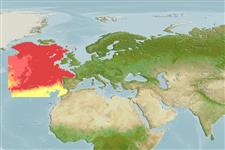>
Zeiformes (Dories) >
Oreosomatidae (Oreos) > Oreosomatinae
Etymology: Neocyttus: Greek, neos = new + Greek, kyttaros, kytos = a convex cavity.
Eponymy: ‘Helga’ was a yacht that belonged to King Edward VII of Great Britain. [...] (Ref. 128868), visit book page.
Environment: milieu / climate zone / depth range / distribution range
Ecologia
marinhas batipelágico; intervalo de profundidade 915 - 1829 m (Ref. 93425). Deep-water; 67°N - 32°N
North Atlantic: widely distributed across the eastern Atlantic. Including the Corner Rise seamounts and those extending from the Mid-Atlantic Ridge towards the New England continental slope and isolated seamounts near Bermuda.
Tamanho / Peso / Idade
Maturity: Lm ? range ? - ? cm
Max length : 30.5 cm TL macho/indeterminado; (Ref. 43998)
Descrição breve
Chaves de identificação | Morfologia | Morfometria
Espinhos dorsais (total) : 6 - 7; Raios dorsais moles (total) : 34 - 35; Espinhos anais: 3 - 4; Raios anais moles: 31 - 32. Body high, diamond shape and expanded laterally . Dark gray in color. Large eyes, protruding small mouth and large spiny rays present at anterior edges of dorsal and anal fins (Ref. 43998).
Life cycle and mating behavior
Maturidade | Reprodução | Desova | Ovos | Fecundidade | Larvas
Karrer, C., 1986. Oreosomatidae. p. 775-776. In P.J.P. Whitehead, M.-L. Bauchot, J.-C. Hureau, J. Nielsen and E. Tortonese (eds.) Fishes of the north-eastern Atlantic and the Mediterranean. UNESCO, Paris. Vol. 2. (Ref. 6750)
Categoria na Lista Vermelha da IUCN (Ref. 130435: Version 2024-1)
Ameaça para o homem
Harmless
Utilização humana
Ferramentas
Relatórios especiais
Descarregue XML
Fontes da internet
Estimates based on models
Preferred temperature (Ref.
123201): 4.3 - 8, mean 5.7 °C (based on 20 cells).
Phylogenetic diversity index (Ref.
82804): PD
50 = 0.5635 [Uniqueness, from 0.5 = low to 2.0 = high].
Bayesian length-weight: a=0.01622 (0.00733 - 0.03589), b=3.02 (2.82 - 3.22), in cm total length, based on LWR estimates for this (Sub)family-body shape (Ref.
93245).
Nível Trófico (Ref.
69278): 3.5 ±0.5 se; based on size and trophs of closest relatives
Resiliência (Ref.
120179): Muito baixo, tempo mínimo de duplicação da população maior que 14 anos (Preliminary K or Fecundity.).
Fishing Vulnerability (Ref.
59153): Low vulnerability (21 of 100).
Nutrients (Ref.
124155): Calcium = 11 [3, 57] mg/100g; Iron = 0.326 [0.090, 1.125] mg/100g; Protein = 17.8 [14.9, 20.8] %; Omega3 = 0.178 [0.050, 0.622] g/100g; Selenium = 8.91 [1.94, 41.19] μg/100g; VitaminA = 54.1 [4.7, 652.7] μg/100g; Zinc = 0.524 [0.201, 1.392] mg/100g (wet weight);
